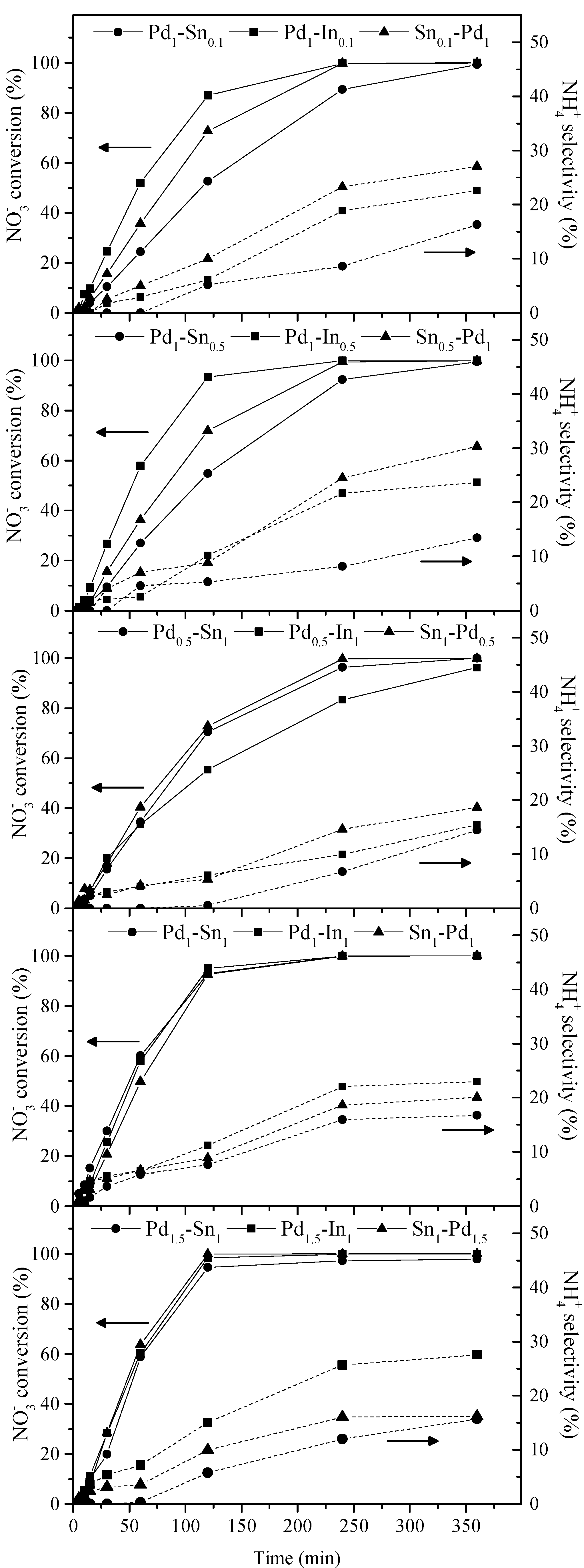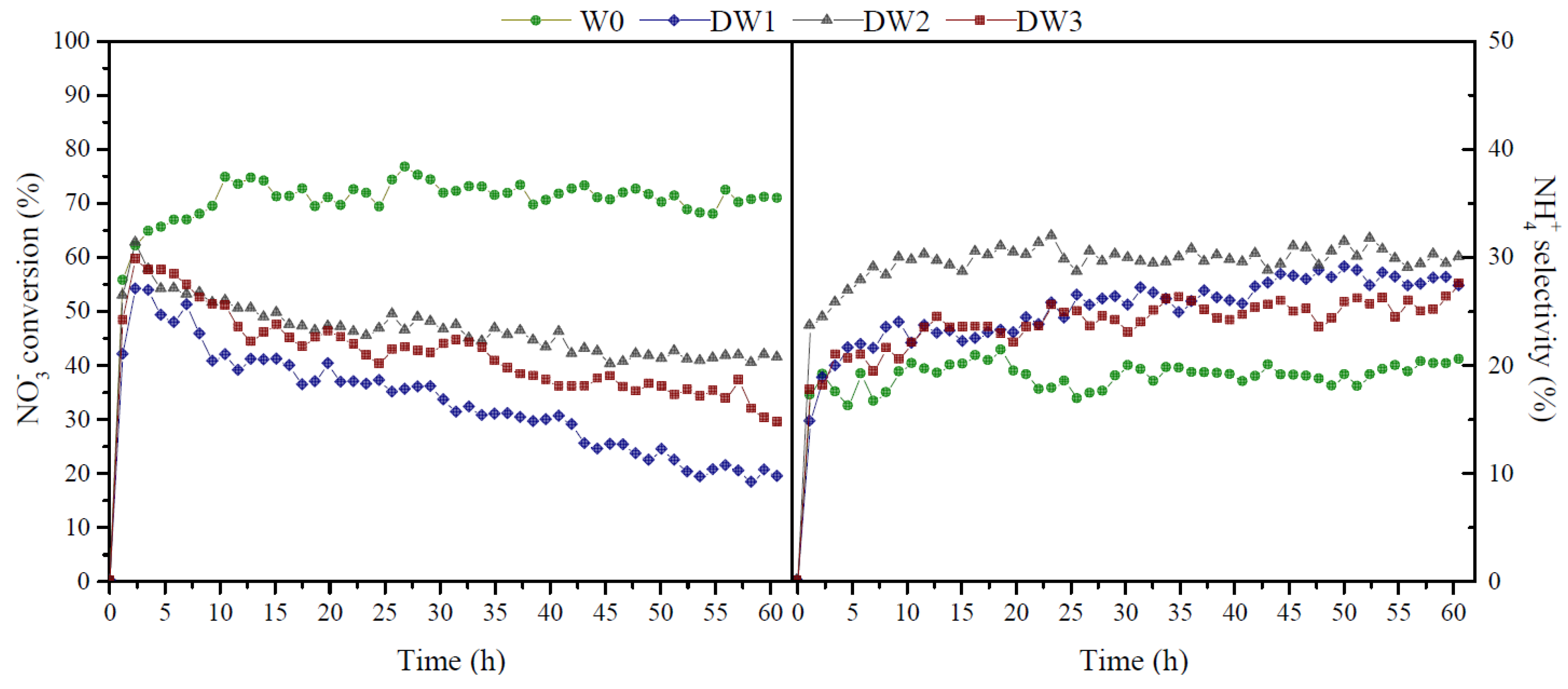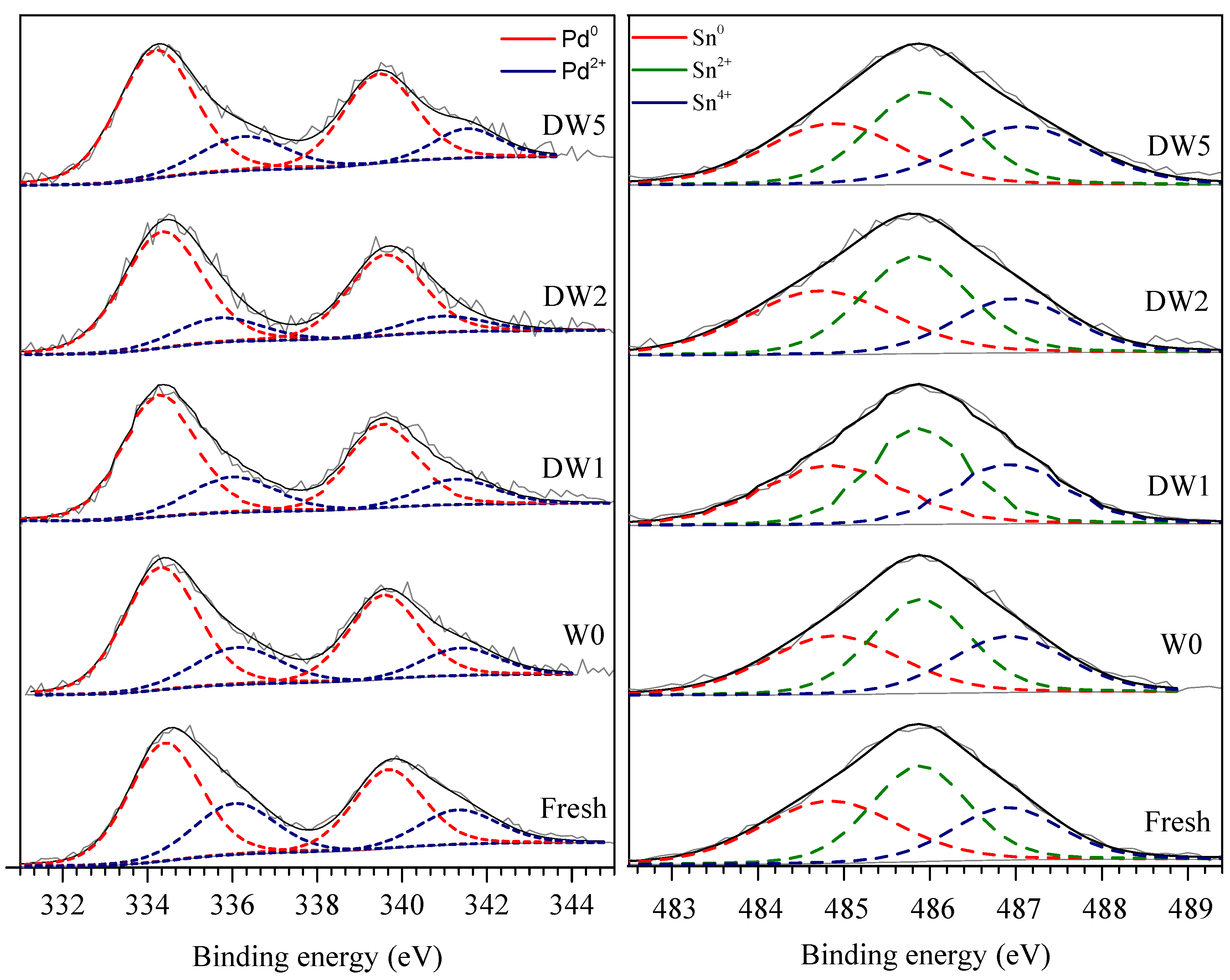Activity and Stability of Pd Bimetallic Catalysts for Catalytic Nitrate Reduction
Abstract
:1. Introduction
2. Results and Discussion
2.1. Catalyst Configuration Effect
2.2. Stability Experiments in Drinking Waters
3. Materials and Methods
3.1. Preparation and Characterization of Catalysts
3.2. Experimental Set-Up and Procedure
3.3. Analytical Methods
4. Conclusions
Author Contributions
Funding
Data Availability Statement
Acknowledgments
Conflicts of Interest
References
- Mesa, J.M.C.; Armendáriz, C.R.; De La Torre, A.H. Nitrate intake from drinking water on Tenerife Island (Spain). Sci. Total Environ. 2003, 302, 85–92. [Google Scholar]
- Espejo-Herrera, N.; Cantor, K.P.; Malats, N.; Silverman, D.T.; Tardón, A.; García-Closas, R.; Serra, C.; Kogevinas, M.; Villanueva, C.M. Nitrate in drinking water and bladder cancer risk in Spain. Environ. Res. 2015, 137, 299–307. [Google Scholar] [CrossRef] [PubMed]
- Ward, M.H.; Jones, R.R.; Brender, J.D.; de Kok, T.M.; Weyer, P.J.; Nolan, B.T.; Villanueva, C.M.; van Breda, S.G. Drinking water nitrate and human health: An updated review. Int. J. Environ. Res. Public Health 2018, 15, 1557. [Google Scholar] [CrossRef] [PubMed] [Green Version]
- European Union. Council Directive 91/676/EEC of 12 December 1991 concerning the protection of waters against pollution caused by nitrates from agricultural sources. Off. J. Eur. Communities 1991, 375, 1–8. [Google Scholar]
- World Health Organization. Nitrate and Nitrite in Drinking-Water: Background Document for Development of WHO Guidelines for Drinking-Water Quality. 2003. Available online: https://apps.who.int/iris/handle/10665/75380 (accessed on 27 June 2022).
- Santos, A.G.G.; Restivo, J.; Orge, C.A.; Pereira, M.F.R.; Soares, O.S.G.P. Influence of organic matter formed during oxidative processes in the catalytic reduction of nitrate. J. Environ. Chem. Eng. 2021, 9, 105545. [Google Scholar] [CrossRef]
- Centi, G.; Perathoner, S. Remediation of water contamination using catalytic technologies. Appl. Catal. B 2003, 41, 15–29. [Google Scholar] [CrossRef]
- Martínez, J.; Ortiz, A.; Ortiz, I. State-of-the-art and perspectives of the catalytic and electrocatalytic reduction of aqueous nitrates. Appl. Catal. B 2017, 207, 42–59. [Google Scholar] [CrossRef] [Green Version]
- Tokazhanov, G.; Ramazanova, E.; Shanawar, H.; Bae, S.; Lee, W. Advances in the catalytic reduction of nitrate by metallic catalysts for high efficiency and N2 selectivity: A review. Chem. Eng. J. 2020, 384, 123252. [Google Scholar] [CrossRef]
- Sanchis, I.; Diaz, E.; Pizarro, A.H.; Rodriguez, J.J.; Mohedano, A.F. Nitrate reduction with bimetallic catalysts. A stability-addressed overview. Sep. Purif. Technol. 2022, 290, 120750. [Google Scholar] [CrossRef]
- Vorlop, K.D.; Tacke, T. Erste schritte auf dem weg zur edelmetallkatalysierten nitrat- und nitrit-entfernung aus trinkwasser. Chem. Ing. Tech. 1989, 61, 836–837. [Google Scholar] [CrossRef]
- Chaplin, B.P.; Roundy, E.; Guy, K.A.; Shapley, J.R.; Werth, C.J. Effects of natural water ions and humic acid on catalytic nitrate reduction kinetics using an alumina supported Pd-Cu catalyst. Environ. Sci. Technol. 2006, 40, 3075–3081. [Google Scholar] [CrossRef] [PubMed]
- Wang, Y.; Sakamoto, Y.; Kamiya, Y. Remediation of actual groundwater polluted with nitrate by the catalytic reduction over copper–palladium supported on active carbon. Appl. Catal. A 2009, 361, 123–129. [Google Scholar] [CrossRef] [Green Version]
- Hirayama, J.; Kamiya, Y. Tin-palladium supported on alumina as a highly active and selective catalyst for hydrogenation of nitrate in actual groundwater polluted with nitrate. Catal. Sci. Technol. 2018, 8, 4985–4993. [Google Scholar] [CrossRef]
- Sanchis, I.; Díaz, E.; Pizarro, A.H.; Rodríguez, J.J.; Mohedano, A.F. Effect of water composition on catalytic reduction of nitrate. Sep. Purif. Technol. 2021, 255, 117766. [Google Scholar] [CrossRef]
- Prüsse, U.; Vorlop, K.D. Supported bimetallic palladium catalysts for water-phase nitrate reduction. J. Mol. Catal. A Chem. 2001, 173, 313–328. [Google Scholar] [CrossRef]
- Zhang, F.; Miao, S.; Yang, Y.; Zhang, X.; Chen, J.; Guan, N. Size-dependent hydrogenation selectivity of nitrate on Pd-Cu/TiO2 catalysts. J. Phys. Chem. C 2008, 112, 7665–7671. [Google Scholar] [CrossRef]
- Soares, O.S.G.P.; Orfao, J.J.M.; Pereira, M.F.R. Bimetallic catalysts supported on activated carbon for the nitrate reduction in water: Optimization of catalysts composition. Appl. Catal. B 2009, 91, 441–448. [Google Scholar] [CrossRef]
- Pizarro, A.H.; Molina, C.B.; Rodriguez, J.J.; Epron, F. Catalytic reduction of nitrate and nitrite with mono- and bimetallic catalysts supported on pillared clays. J. Environ. Chem. Eng. 2015, 3, 2777–2785. [Google Scholar] [CrossRef]
- Durkin, D.P.; Ye, T.; Choi, J.; Livi, K.J.T.; De Long, H.C.; Trulove, P.C.; Fairbrother, D.H.; Haverhals, L.M.; Shuai, D. Sustainable and scalable natural fiber welded palladium-indium catalysts for nitrate reduction. Appl. Catal. B 2018, 221, 290–301. [Google Scholar] [CrossRef]
- Mendow, G.; Veizaga, N.S.; Querini, C.A.; Sánchez, B.S. A continuous process for the catalytic reduction of water nitrate. J. Environ. Chem. Eng. 2019, 7, 102808. [Google Scholar] [CrossRef]
- Jung, S.; Bae, S.; Lee, W. Development of Pd-Cu/hematite catalyst for selective nitrate reduction. Environ. Sci. Technol. 2014, 48, 9651–9658. [Google Scholar] [CrossRef] [PubMed]
- Hamid, S.; Kumar, M.A.; Lee, W. Highly reactive and selective Sn-Pd bimetallic catalyst supported by nanocrystalline ZSM-5 for aqueous nitrate reduction. Appl. Catal. B 2016, 187, 37–46. [Google Scholar] [CrossRef]
- Theologides, C.P.; Savva, P.G.; Costa, C.N. Catalytic removal of nitrates from waters in a continuous flow process: The remarkable effect of liquid flow rate and gas feed composition. Appl. Catal. B 2011, 102, 54–61. [Google Scholar] [CrossRef]
- Hamid, S.; Golagana, S.; Han, S.; Lee, G.; Babaa, M.R.; Lee, W. Stability of Sn-Pd-Kaolinite catalyst during heat treatment and nitrate reduction in continuous flow reaction. Chemosphere 2020, 241, 125115. [Google Scholar] [CrossRef] [PubMed]
- Palomares, A.E.; Franch, C.; Corma, A. Nitrates removal from polluted aquifers using (Sn or Cu)/Pd catalysts in a continuous reactor. Catal. Today 2010, 149, 348–351. [Google Scholar] [CrossRef]
- Palomares, A.E.; Franch, C.; Corma, A. A study of different supports for the catalytic reduction of nitrates from natural water with a continuous reactor. Catal. Today 2011, 172, 90–94. [Google Scholar] [CrossRef]
- Franch, C.; Rodríguez-Castellón, E.; Reyes-Carmona, A.; Palomares, A.E. Characterization of (Sn and Cu)/Pd catalysts for the nitrate reduction in natural water. Appl. Catal. A 2012, 425, 145–152. [Google Scholar] [CrossRef]
- Soares, O.S.G.P.; Orfao, J.J.M.; Gallegos-Suarez, E.; Castillejos, E.; Rodríguez-Ramos, I.; Pereira, M.F.R. Nitrate reduction over a Pd-Cu/MWCNT catalyst: Application to a polluted groundwater. Environ. Technol. 2012, 33, 2353–2358. [Google Scholar] [CrossRef]
- Mendow, G.; Sánchez, A.; Grosso, C.; Querini, C.A. A novel process for nitrate reduction in water using bimetallic Pd-Cu catalysts supported on ion exchange resin. J. Environ. Chem. Eng. 2017, 5, 1404–1414. [Google Scholar] [CrossRef]
- Jaworski, M.A.; Barbero, B.P.; Siri, G.J.; Casella, M.L. Removal of nitrate from drinking water by using PdCu structured catalysts based on cordierite monoliths. Braz. J. Chem. Eng. 2019, 3, 705–715. [Google Scholar] [CrossRef] [Green Version]
- Marchesini, F.A.; Mendow, G.; Picard, N.P.; Zoppas, F.M.; Aghemo, V.S.; Gutierrez, L.B.; Querini, C.A.; Miró, E.E. PdIn catalysts in a continuous fixed bed reactor for the nitrate removal from groundwater. Int. J. Chem. React. Eng. 2019, 17, 20180126. [Google Scholar] [CrossRef]
- Bae, S.; Jung, J.; Lee, W. The effect of pH and zwitterionic buffers on catalytic nitrate reduction by TiO2-supported bimetallic catalyst. Chem. Eng. J. 2013, 232, 327–337. [Google Scholar] [CrossRef]
- Chaplin, B.P.; Shapley, J.R.; Werth, C.J. The selectivity and sustainability of a Pd–In/γ-Al2O3 catalyst in a packed-bed reactor: The effect of solution composition. Catal. Lett. 2009, 130, 56–62. [Google Scholar] [CrossRef]
- Calvo, L.; Gilarranz, M.A.; Casas, J.A.; Mohedano, A.F.; Rodríguez, J.J. Denitrification of water with activated carbon-supported metallic catalysts. Ind. Eng. Chem. Res. 2010, 49, 5603–5609. [Google Scholar] [CrossRef]
- Wang, Q.; Wang, W.; Yan, B.; Shi, W.; Cui, F.; Wang, C. Well-dispersed Pd-Cu bimetals in TiO2 nanofiber matrix with enhanced activity and selectivity for nitrate catalytic reduction. Chem. Eng. J. 2017, 326, 182–191. [Google Scholar] [CrossRef]
- Miyazaki, A.; Matsuda, K.; Papa, F.; Scurtu, M.; Negrila, C.; Dobrescu, G.; Balint, I. Impact of particle size and metal-support interaction on denitration behavior of well-defined Pt-Cu nanoparticles. Catal. Sci. Technol. 2015, 5, 492–503. [Google Scholar] [CrossRef]
- Deganello, F.; Liotta, L.F.; Macaluso, A.; Venezia, A.M.; Deganello, G. Catalytic reduction of nitrates and nitrites in water solution on pumice-supported Pd–Cu catalysts. Appl. Catal. B 2000, 24, 265–273. [Google Scholar] [CrossRef]
- Soares, O.S.G.P.; Orfao, J.J.M.; Pereira, M.F.R. Nitrate reduction catalyzed by Pd-Cu and Pt-Cu supported on different carbon materials. Catal. Lett. 2010, 139, 97–104. [Google Scholar] [CrossRef]
- Batista, J.; Pintar, A.; Mandrino, D.; Jenko, M.; Martin, V. XPS and TPR examinations of γ-alumina-supported Pd-Cu catalysts. Appl. Catal. A 2001, 206, 113–124. [Google Scholar] [CrossRef]
- Aristizábal, A.; Contreras, S.; Divins, N.J.; Llorca, J.; Medina, F. Effect of impregnation protocol in the metallic sites of Pt–Ag/activated carbon catalysts for water denitration. Appl. Surf. Sci. 2014, 298, 75–89. [Google Scholar] [CrossRef]
- Pintar, A.; Batista, J.; Arcon, I.; Kodre, A. Characterization of γ-A12O3 supported Pd-Cu bimetallic catalysts by EXAFS, AES and kinetic measurements. Stud. Surf. Sci. Catal. 1998, 118, 127–136. [Google Scholar]
- Park., J.; Hwang, Y.; Bae, S. Nitrate reduction on surface of Pd/Sn catalysts supported by coal fly ash derived zeolites. J. Hazard. Mater. 2019, 374, 309–318. [Google Scholar] [CrossRef] [PubMed]
- Pizarro, A.H.; Torija, I.; Monsalvo, V.M. Enhancement of Pd-based catalysts for the removal of nitrite and nitrate from water. J. Water Supply Res. Technol. 2018, 67, 615–625. [Google Scholar] [CrossRef] [Green Version]
- Devadas, A.; Vasudevan, S.; Epron, F. Nitrate reduction in water: Influence of the addition of a second metal on the performances of the Pd/CeO2 catalyst. J. Hazard. Mater. 2011, 185, 1412–1417. [Google Scholar] [CrossRef]
- Sá, J.; Gasparovicova, D.; Hayek, K.; Halwax, E.; Anderson, J.A.; Vinek, H. Water denitration over a Pd–Sn/Al2O3 catalyst. Catal. Lett. 2005, 105, 209–217. [Google Scholar] [CrossRef]
- Gao, Z.; Zhang, Y.; Li, D.; Werth, C.J.; Zhang, Y.; Zhou, X. Highly active Pd–In/mesoporous alumina catalyst for nitrate reduction. J. Hazard. Mater. 2015, 286, 425–431. [Google Scholar] [CrossRef]
- Baeza, J.A.; García-Missana, F.; Oliveira, A.S.; Calvo, L.; Gilarranz, M.A. Influence of H2 availability in the catalytic reduction of nitrates in fixed bed reactors. Chem. Eng. Sci. 2021, 246, 116887. [Google Scholar] [CrossRef]
- Matatov-Meytal, Y.; Barelko, V.; Yuranov, I.; Kiwi-Minsker, L.; Renken, A.; Sheintuch, M. Cloth catalysts for water denitrification II. Removal of nitrates using Pd–Cu supported on glass fibers. Appl. Catal. B 2001, 31, 233–240. [Google Scholar] [CrossRef] [Green Version]
- Marchesini, F.A.; Aghemo, V.; Moreno, I.; Navascués, N.; Irusta, S.; Gutierrez, L. Pd and Pd, In nanoparticles supported on polymer fibres as catalysts for the nitrate and nitrite reduction in aqueous media. J. Environ. 2020, 8, 103651. [Google Scholar] [CrossRef]



| Catalyst | Metal Content (wt.%) | ABET (m2 g−1) | Vmesopore (cm3 g−1) | Selectivity at X-NO3− = 95% | First-Order Kinetic Constant (X-NO3− < 95%) | |||
|---|---|---|---|---|---|---|---|---|
| NH4+ | NO2− | N2 | k × 103 (L min−1 gcat−1) | R2 | ||||
| Sn0.1–Pd1 | 0.1−0.9 | 151 | 0.45 | 20.9 | 0.4 | 78.7 | 12.6 ± 0.9 | 0.97 |
| Sn0.5–Pd1 | 0.4−1.1 | 149 | 0.45 | 22.0 | 0.5 | 77.5 | 12.5 ± 0.9 | 0.97 |
| Sn1–Pd1 | 0.8−1.0 | 151 | 0.45 | 12.1 | 0.0 | 87.9 | 18.8 ± 1.4 | 0.97 |
| Sn1–Pd0.5 | 0.9−0.4 | 148 | 0.46 | 13.0 | 0.1 | 86.9 | 12.7 ± 0.8 | 0.98 |
| Sn1–Pd1.5 | 0.8−1.3 | 145 | 0.43 | 9.1 | 0.0 | 90.9 | 23.6 ± 2.7 | 0.94 |
| Pd1–Sn0.1 | 1.1−0.1 | 152 | 0.45 | 13.1 | 0.0 | 86.9 | 9.1 ± 0.5 | 0.98 |
| Pd1–Sn0.5 | 1.0−0.4 | 155 | 0.45 | 10.1 | 0.4 | 89.5 | 10.1 ± 0.6 | 0.98 |
| Pd1–Sn1 | 0.8−0.8 | 154 | 0.46 | 9.5 | 0.0 | 90.5 | 19.5 ± 1.0 | 0.98 |
| Pd0.5–Sn1 | 0.5−0.7 | 155 | 0.46 | 6.5 | 0.3 | 93.2 | 11.9 ± 0.8 | 0.98 |
| Pd1.5–Sn1 | 1.6−0.9 | 154 | 0.46 | 6.6 | 0.6 | 92.8 | 21.7 ± 1.6 | 0.97 |
| Pd1–In0.1 | 0.9−0.1 | 152 | 0.46 | 14.2 | 0.4 | 85.4 | 15.4 ± 0.7 | 0.99 |
| Pd1–In0.5 | 0.8−0.4 | 148 | 0.45 | 13.0 | 0.7 | 86.3 | 20.1 ± 1.3 | 0.98 |
| Pd1–In1 | 1.0−0.8 | 152 | 0.46 | 11.3 | 0.0 | 88.7 | 23.1 ± 1.8 | 0.96 |
| Pd0.5–In1 | 0.3−0.7 | 151 | 0.45 | 14.9 | 0.6 | 84.5 | 8.1 ± 0.3 | 0.99 |
| Pd1.5–In1 | 1.5−0.7 | 146 | 0.44 | 14.4 | 0.4 | 85.2 | 22.9 ± 2.7 | 0.94 |
| Catalyst | Metal Content (wt%) | First-Order Kinetic Constant | X-NO3− (%) | S-N2 (%) | Reference |
|---|---|---|---|---|---|
| Pd-Sn/Al2O3 | 0.5−5 | 8.4 × 10−3 L min−1 gcat−1 | 95 | 91.7 | [15] |
| Pd-Sn/Al2O3 | 1.5−1.5 | 36 × 10−3 L min−1 gcat−1 | 100 | 74.7 | [43] |
| Pd-In/Al2O3 | 1−0.25 | 100 | 86.0 | [32] | |
| Pd-Sn/Al2O3 | 5−1.25 | 100 | 44 | [44] | |
| Pd-In/Al2O3 | 5−1.25 | 100 | 66 | [44] | |
| Pd-In/Al2O3 | 5−2 | 100 | 75.4 | [45] | |
| Pd-In/Al2O3 | 1−0.25 | 100 | 72.3 | [27] | |
| Pd-Sn/Al2O3 | 4.4−1.2 | 100 | 88 | [46] | |
| Pd-In/Al2O3 | 5−1.25 | 0.24 L min−1 gcat−1 | 100 | 72.1 | [47] |
| Pd-Sn/Al2O3 | 1.5−1 | 21.7 × 10−3 L min−1 gcat−1 | 95 | 92.8 | This study |
| Pd-In/Al2O3 | 1−1 | 23.1 × 10−3 L min−1 gcat−1 | 95 | 88.7 | This study |
| Fresh Catalyst | Used Catalyst | ||||
|---|---|---|---|---|---|
| W0 | DW1 | DW2 | DW3 | ||
| C (%) | 0.2 | 0.2 | 0.2 | 0.2 | 0.2 |
| H (%) | 0.8 | 0.9 | 2.5 | 1.0 | 2.8 |
| N (%) | <0.1 | <0.1 | <0.1 | <0.1 | <0.1 |
| S (%) | <0.1 | <0.1 | <0.1 | <0.1 | <0.1 |
| ABET (m2 g−1) | 154 | 155 | 150 | 152 | 152 |
| Vmeso (cm3 g−1) | 0.46 | 0.45 | 0.43 | 0.45 | 0.44 |
| Pd (%) | 1.53 | 1.52 | 1.47 | 1.50 | 1.39 |
| Sn (%) | 0.86 | 0.87 | 0.82 | 0.87 | 0.81 |
| Fresh Catalyst | Used Catalyst | ||||
|---|---|---|---|---|---|
| W0 | DW1 | DW2 | DW3 | ||
| C (%) | 4.1/2.2 | 4.5/2.4 | 4.7/2.4 | 8.2/4.3 | 5.0/2.7 |
| O (%) | 50.1/35.0 | 51.2/36.1 | 50.6/35.1 | 48.0/33.8 | 50.5/35.8 |
| Al (%) | 38.0/44.8 | 39.0/46.4 | 38.1/44.6 | 40.4/48.0 | 39.1/46.7 |
| S (%) | 4.4/6.2 | 3.2/4.5 | 4.0/5.6 | 0.9/1.3 | 3.4/4.8 |
| Pd (%) | 1.0/4.6 | 0.9/4.2 | 1.0/4.6 | 1.0/4.7 | 0.8/3.8 |
| Pd0 (%) | 67.3 | 73.9 | 74.1 | 81.4 | 77.0 |
| Pd2+ (%) | 32.7 | 26.1 | 25.9 | 18.6 | 23.0 |
| Sn (%) | 1.4/7.3 | 1.2/6.3 | 1.5/7.7 | 1.5/7.8 | 1.2/6.3 |
| Sn0 (%) | 36.4 | 33.3 | 33.6 | 36.1 | 32.2 |
| Sn2+ (%) | 39.6 | 39.1 | 39.1 | 39.9 | 37.3 |
| Sn4+ (%) | 24.1 | 27.6 | 27.4 | 24.0 | 30.5 |
| Water | Dry Residue 180 °C | Hardness | pH | Conductivity | Na+ | K+ | Ca2+ | Mg2+ | NH4+ | NO3− | Cl− | SO42− | HCO3− |
|---|---|---|---|---|---|---|---|---|---|---|---|---|---|
| mg L−1 | mg CaCO3; L−1 | µS cm−1 | mg L−1 | ||||||||||
| DW1 | 260 | 264 | 7.5 | 493 | 5.8 | 0.8 | 62.9 | 25.9 | 0.4 | 2.5 | 7.3 | 22.6 | 255.1 |
| DW2 | 12 | 14 | 6.1 | 32 | 3.0 | 0.2 | 3.9 | 1.1 | 0.4 | 6.7 | - | 2.6 | 8.9 |
| DW3 | 521 | 257 | 8.2 | 874 | 89.4 | 1.3 | 76.3 | 16.1 | 0.4 | 5.3 | 169.8 | 39.1 | 244.0 |
Publisher’s Note: MDPI stays neutral with regard to jurisdictional claims in published maps and institutional affiliations. |
© 2022 by the authors. Licensee MDPI, Basel, Switzerland. This article is an open access article distributed under the terms and conditions of the Creative Commons Attribution (CC BY) license (https://creativecommons.org/licenses/by/4.0/).
Share and Cite
Sanchis, I.; Rodriguez, J.J.; Mohedano, A.F.; Diaz, E. Activity and Stability of Pd Bimetallic Catalysts for Catalytic Nitrate Reduction. Catalysts 2022, 12, 729. https://doi.org/10.3390/catal12070729
Sanchis I, Rodriguez JJ, Mohedano AF, Diaz E. Activity and Stability of Pd Bimetallic Catalysts for Catalytic Nitrate Reduction. Catalysts. 2022; 12(7):729. https://doi.org/10.3390/catal12070729
Chicago/Turabian StyleSanchis, Ines, Juan Jose Rodriguez, Angel F. Mohedano, and Elena Diaz. 2022. "Activity and Stability of Pd Bimetallic Catalysts for Catalytic Nitrate Reduction" Catalysts 12, no. 7: 729. https://doi.org/10.3390/catal12070729
APA StyleSanchis, I., Rodriguez, J. J., Mohedano, A. F., & Diaz, E. (2022). Activity and Stability of Pd Bimetallic Catalysts for Catalytic Nitrate Reduction. Catalysts, 12(7), 729. https://doi.org/10.3390/catal12070729









